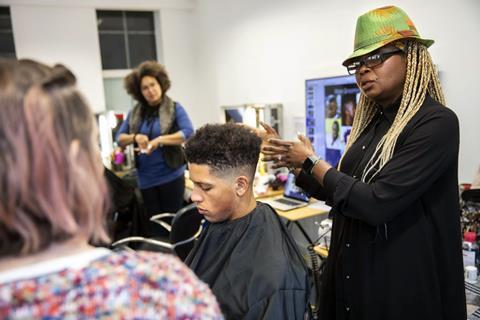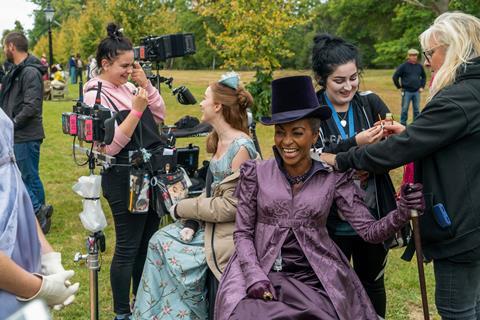What further steps can be taken at training stage to foster a more inclusive workforce in an industry that is still predominantly white, straight and male?

As the breeding ground for emerging talent, there is growing debate around how the industry’s training bodies can bettter lay the groundwork for true diversity.
The issue of inclusivity has long been a hot-button topic in the film and television industries and in recent years the #MeToo and Black Lives Matter movements have only intensified the debate surrounding equality of opportunities in front of and behind the camera.
But report after report accuses the creative industries of remaining the enclave of straight white men — a situation likely to be further embedded thanks to pandemic job losses that have disproportionately targeted freelancers.
The calls for lasting institututional change are growing louder, for an equal slice of the pie for those who identify as black, Asian, minority ethnic, LGBT or disabled, as well as parents, carers and those working outside of major urban centres.
Change is happening. Later this spring the first cohort of five black, Asian and transgender intimacy coordinators in the UK will complete a months-long mentoring programme under the aegis of the Intimacy Coordinators Mentoring Scheme For Underrepresented Groups which has been funded by the Film & TV Charity Fund, ScreenSkills and Moving Body Arts. Until now, the relatively new role of intimacy co-ordinator has only been held by white, cis-gender practioners.
But more practical steps now need to be taken to target craft training for working with non-white individuals.
In a piece entitled ‘Being Seen: inclusivity in lighting’, for Viewfinder, the magazine of the British Universities and Colleges Film & Video Council, Sharon Coleclough, senior lecturer in film production at the UK’s Staffordshire University, argues cinematographers need to be better skilled in the successful lighting and framing of non-white actors.
“Historically lighting, much like film itself, has focused on the white actor,” Coleclough tells Screen. “So the industry has a very fixed definition of lighting need, and this has been reflected through the training that was available. With a greater diversity of actors comes a diversity of skin tones and we need to ensure actors are literally visible, their presence not minimised because of technical choices. Each actor should be lit with consideration to their skin tone; small adaptations concerning the reflectivity of the skin, placement and colour of light, to ensure the actor is seen and their contribution is technically supported.”
That is a view shared by Kamanza Amihyia, hair and make-up artist for stage, film and TV productions including Netflix’s Bridgerton and the BBC’s Small Axe, who has long been disappointed with training for BAME hair and skin. “For a long time it has been ‘the white way is the right way’, so what was lacking was the historic knowledge of how [non-white] hair and make-up should be done and students were being sent out into the industry with no understanding,” she says.
Seeing this huge skills gap, Amihyia first developed a BAME hair and make-up course for the UK’s Bath Academy of Media Make-Up, subsequently taking her expertise to institutions such as the Creative Media Skills Institute, creative industries union Bectu, and stage and theatre organisations in Oslo and Gothenburg.

“Bectu’s training courses on BAME hair and make-up for professional artists were a step in the right direction for inclusivity in the industry,” agrees Philippa Childs, head of Bectu, which began offering Amihyia’s training in 2019. “They started in response to members highlighting gaps in the core curriculum of professional hair and make-up courses, with some lacking the skills needed for working with BAME actors. Bectu recognises that BAME underrepresentation on and off camera remains a huge problem, and we will continue in our efforts to diversify the industry.”
A large part of achieving genuine inclusivity, says Amihyia, is to make the industry more familiar with the culture behind the craft. “When we traditionally [think about] hair and make-up for darker skin, it is usually about slavery, slavery, slavery,” she notes about the inaccuracies of black history education and the types of roles afforded to black actors, which inform general misconceptions of style. “I wanted to teach beyond that — about how, in the 13th, 14th, 15th centuries, Africans came over to help build Europe, and contributed their hairstyles and fashion. As designers, as make-up artists, we are telling a story about history. If you don’t have the correct knowledge, your hair and make-up design is just not going to be accurate.”
While Amihyia believes the Black Lives Matter movement has done a huge amount to help improve industry understanding of BAME cultures, she still believes there is a way to go before that is reflected in on-the-ground training. “People are screaming out for black creatives,” she says. “But what our industry doesn’t yet understand is that, just because someone is black or Asian, it doesn’t mean you instinctively know how to do black or Asian hair and make-up. On my course, I take care to have all ethnicities — black, white, east Asian, south Asian. It’s important we all get the right training. But it needs to be regulated. We need to have people who are respected in their field setting standards for these courses across the board.”
Positive steps
What is apparent is that there is a genuine commitment to inclusion at training level in the UK.
“The wider BFI Future Film Skills Programme, delivered by ScreenSkills, has inclusion as a priority woven into the supported training initiatives, and is performing well above the industry workforce figures in terms of supporting individuals from underrepresented groups,” says BFI chief executive Ben Roberts. “And we recently announced the Early Stage Access and Diversity Accelerator Programme, delivered by the NFTS, which will enable more people from underrepresented groups to benefit from the world-class industry training.”
Roberts also points to the BFI Film Academy Future Skills programme, which sees young people employed as paid trainees on feature productions. Through the four iterations of the programme, 73% of the trainees were women, 38% were from underrepresented ethnic backgrounds, 12% identify as disabled and 58% were recruited from outside London. Some 70% of trainees went on to secure regular work. This commitment to inclusion schemes, however, does not yet seem to be translating to widespread diversity in the workforce.
“As an industry we talk a lot, and we mean it, but we tend to do a lot of fragmented, disparate initiatives,” says Seetha Kumar, CEO of ScreenSkills and board member of the Creative Diversity Network. While ScreenSkills supports a number of diversity schemes including an annual conference and training for BAME individuals, Kumar sees the need for a broader approach.
“I am obsessed with creating an infrastructure and being data-driven,” she says. “Going back to basics, it’s about enabling everyone to see the breadth of job roles available and ensuring access to the industry is not just through higher education. We need a professionalised, standardised approach and joined-up pathways to work. How do we support people in next steps beyond bursaries and mentorships?”
Roberts agrees it is not about simply uplifting marginalised talent, but a change in engrained attitudes. “To truly improve inclusion, we need to go beyond training and open the doors to enable people from underrepresented groups to develop their careers on an ongoing basis,” he says. “We are working hard to address systematic barriers at every stage of a person’s career, for example, through our support of the ScreenSkills unconscious bias training.”
Amihyia is optimistic for the future. ”For me, it’s about inclusion,” she says. ”And the industry is finally taking some positive steps in the right direction.”

























No comments yet